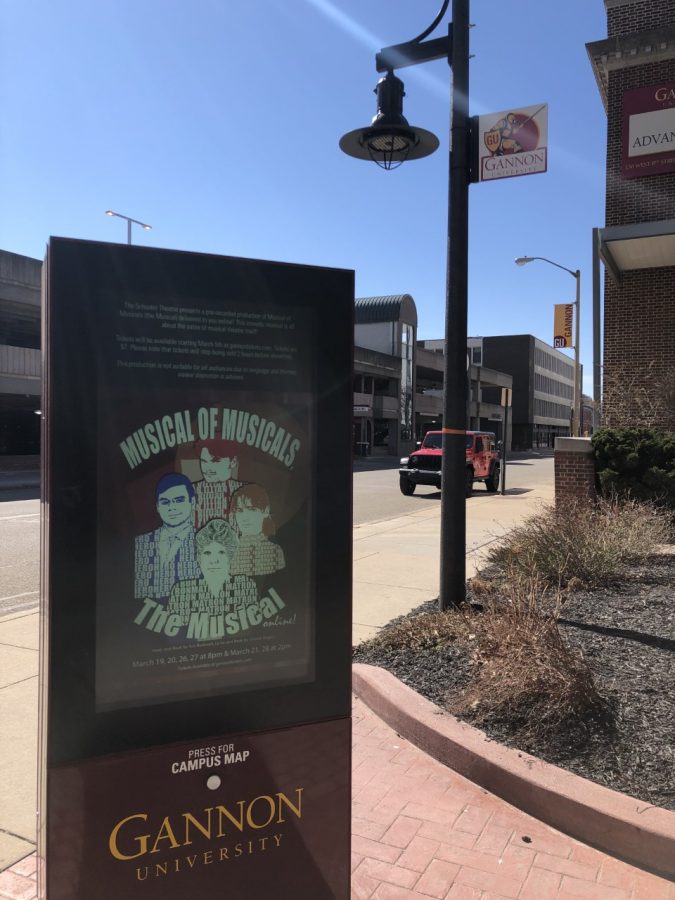Making memories with a different kind of show
March 30, 2021
“Musical of Musicals (The Musicals!)” is the most recent theatrical production put on by the cast at the Schuster Theater. This show is a satirical collection of scenes about five popular and very different musicals.
The musical first debuted off Broadway in 2003 and was written by Joanne Bogart and Eric Rockwell.
On the Gannon University campus, the theater has been facing many challenges during the COVID-19 pandemic, but those involved were determined to continue to perform and pursue their passion for musical theater.
Although the members of the Schuster Theater were aware this would be a virtual performance, they did not take their roles any less seriously as designers and performers.
Angela Howell, an assistant theater professor and technical director for the Schuster Theatre, spoke to her role in this production in the midst of the pandemic and an exhausting semester for all, which doubtlessly required a performance from within our Erie community to bring some light and relaxation to the city.
Throughout the first half of the semester, Howell and the theater crew tirelessly progressed through designing their own set from scratch and preparing for the big debut.
Theater student Petra Shearer said she thought the performance went very well.
“We definitely took a risk and tried something we had never done before at the Schuster,” she said. “I was nervous how it would turn out, but I think the cast and crew should be proud of the work we did, especially in this time of COVID-19.”
Howell also admitted that COVID-19 significantly changed the dynamic of the performance.
“I can’t speak for the actors, although I suspect that they missed the exchange of energy and the applause from the audience,” she said. “The entire process was tough and intense.
“Most of the actors and technicians had little or no experience working in filmed performance. It is quite different. I had no idea how to light for the camera so I consulted experts. I still wasn’t satisfied, but I am rarely satisfied with my own work.”
She also noted how anticlimactic and exhausting the whole process was as well, carrying over the tired weight of the entire campus onto their production, as it is for the most part student-produced, just like our paper.
“We filmed three Saturdays in a row and when we finished it seemed anticlimactic,” she said. “We usually work and work and work up to opening night and there is excitement and energy as the house fills and the show begins. After there is applause and a party. This time we worked and worked and worked and it was just over. The show was in post-production for a week and then aired.”
To speak to how it felt being an actor for a filmed theatrical production, Shearer also noted that not having an audience was a tremendous game-changer.
“It was a totally different experience performing without an audience,” she said. “For the last show, ‘The Grown Up,’ we did not have an audience because we performed live on Zoom. However, with the format for that show we didn’t need the audience interaction.
“With this show, it was so over the top and performative, I wish we could have had an audience. Musicals benefit so much from a live audience; actors thrive off of the energy from good, interactive audiences. We just had to imagine the audience’s reactions and feed off of each other’s energy.”
Shearer said performing during COVID was also a challenge, but she thought the cast adjusted quickly.
“It was a struggle to maintain our distance, but we used careful blocking to solve this,” she said. “We blended the masks in with the costuming and adjusted our acting to make up for the lack of facial expressions. Overall, we tried to work with our obstacles instead of being hindered by them.”
In addition to adjusting to not having an audience, the technical department had to venture into pre-recording and adjusting its equipment to accommodate the ears of the devices, not to the ears of a live audience.
“I’m the technical director for every show, which means that I am ultimately responsible for all tech,” Howell said. “Sometimes that means that I do everything, sometimes that means that I guide student designers through the process and sometimes I hire people to do things that I can’t.
“I was fortunate to have great student designers working on costumes (Camryn Grey) and scenery (Nico Lombardo) and also quite a bit of help from David Blaetz in the Communications Department and CAM TV coming to film. I was left designing lights, which is not something that I have a lot of experience in. I’m pleased with the result of my design, but there are about 42 things I would do differently next time!”
Shearer and Howell agreed that given the conditions they were given to perform in, the production was a success, and they each have something new to add to their repertoire as performers and producers.
The next performance date set at the Schuster is still a work in progress, but more information should be available soon about the next production we can look forward to as a Gannon community.
ALI SMITH
[email protected]





